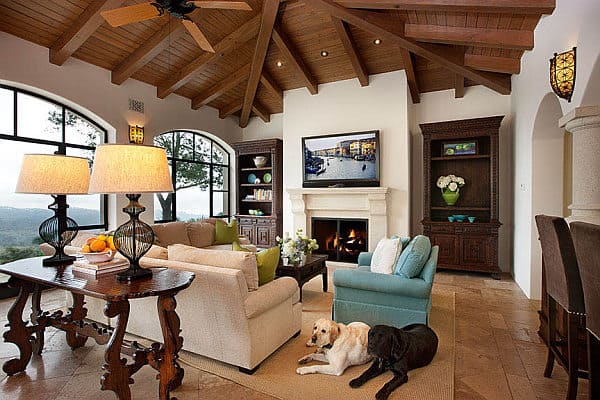Traditional Spanish style interiors have long been celebrated for their vibrant colors, intricate patterns, and warm, welcoming atmosphere. In recent years, there has been a surge in blending these timeless elements with modern touches to create spaces that are both classic and contemporary. This article delves into how to incorporate modern touches into traditional Spanish style interiors, offering detailed insights and practical tips to achieve this harmonious fusion.
Understanding Traditional Spanish Style Interiors
Traditional Spanish interiors are characterized by several distinctive features:
- Color Palette: Rich, warm hues such as terracotta, ochre, and deep blues dominate the color scheme.
- Materials: Natural materials like wood, wrought iron, and ceramic tiles are frequently used.
- Architectural Elements: Arched doorways, exposed wooden beams, and stucco walls are key architectural features.
- Decorative Details: Intricate tile work, hand-painted designs, and ornate furniture are common.
These elements create a cozy and inviting atmosphere that reflects the rich cultural heritage of Spain. The challenge lies in introducing modern elements without overshadowing these traditional features.
Incorporating Modern Color Schemes
While the traditional Spanish color palette is warm and earthy, modern design often favors neutral and cool tones. Incorporating modern color schemes can be done by:
- Neutral Bases: Start with a neutral base for walls, such as white or light grey. This creates a clean canvas that highlights traditional elements like wooden beams or colorful tiles.
- Accent Colors: Use traditional colors as accents. For example, terracotta cushions or deep blue ceramics can add vibrancy without overwhelming the space.
- Bold Statements: Consider using modern, bold colors sparingly to create focal points. A single piece of furniture in a striking color can add a contemporary touch to a traditionally styled room.
Blending Modern and Traditional Materials
The fusion of modern and traditional materials can enhance the aesthetic appeal of Spanish interiors. Blending materials effectively involves:
- Mixing Textures: Combine smooth, sleek materials like glass and metal with rustic, textured elements such as wood and stone. For instance, a modern glass coffee table can be paired with a traditional wooden sofa.
- Contrasting Finishes: Use contrasting finishes to create visual interest. Matte and glossy finishes can be juxtaposed to add depth and dimension to a room.
- Sustainable Choices: Modern design often emphasizes sustainability. Integrate eco-friendly materials that complement traditional elements, such as reclaimed wood or recycled metal.
Modern Furniture in Traditional Spaces
Selecting the right furniture is crucial for blending modern touches with traditional Spanish interiors. Modern furniture can be integrated by:
- Minimalist Designs: Choose furniture with clean lines and simple designs. This contrasts beautifully with the ornate details of traditional Spanish furniture.
- Functional Pieces: Opt for multifunctional furniture that offers practicality without compromising style. A sleek sofa bed or a modern dining table with storage can enhance the functionality of a space.
- Statement Pieces: Incorporate a few contemporary statement pieces, such as a modern armchair or a chic coffee table, to add a touch of elegance and sophistication.
Modern Lighting Solutions
Lighting plays a vital role in setting the ambiance of a space. Modern lighting solutions can be used to highlight traditional features while adding a contemporary flair. Consider the following lighting strategies:
- Layered Lighting: Use a combination of ambient, task, and accent lighting to create a well-lit, inviting space. Modern pendant lights, traditional chandeliers, and recessed lighting can work together harmoniously.
- Natural Light: Maximize natural light by using sheer curtains or blinds that allow sunlight to filter through. Large windows or skylights can also enhance the sense of space and openness.
- Innovative Fixtures: Choose innovative lighting fixtures that serve as focal points. A modern chandelier or geometric pendant light can add a stylish touch to a traditional room.
Combining Traditional Decor with Modern Art
Art and decor are essential elements in any interior design. To successfully combine traditional decor with modern art, consider the following tips:
- Eclectic Mix: Create an eclectic mix by combining traditional Spanish decor, such as hand-painted tiles and wrought iron accessories, with modern art pieces like abstract paintings or contemporary sculptures.
- Balanced Placement: Place modern art in prominent locations to draw attention while ensuring it complements traditional elements. A modern painting above a rustic fireplace can create a striking visual balance.
- Thematic Consistency: Maintain a thematic consistency by selecting modern art that resonates with the colors, patterns, or themes of traditional decor. This ensures a cohesive and harmonious look.
Innovative Use of Space
Modern design often emphasizes the efficient use of space. To integrate modern functionality into traditional Spanish interiors:
- Open Floor Plans: Consider open floor plans that allow for a seamless flow between rooms. This modern approach can enhance the spaciousness of traditional interiors.
- Built-In Storage: Utilize built-in storage solutions that blend with traditional architectural elements. Custom-built cabinets or shelves can offer modern convenience without disrupting the traditional aesthetic.
- Flexible Spaces: Create flexible spaces that can adapt to various needs. For example, a traditional dining area can double as a workspace with the addition of modern furniture and accessories.
Integrating Technology
Incorporating modern technology into traditional Spanish interiors can enhance comfort and convenience without compromising style. Consider these tech-savvy solutions:
- Smart Home Systems: Install smart home systems that control lighting, climate, and security. These systems can be discreetly integrated into traditional designs.
- Hidden Tech: Use hidden technology to maintain the aesthetic appeal of traditional interiors. Concealed speakers, built-in charging stations, and wireless devices can offer modern functionality without being visually intrusive.
- Energy Efficiency: Embrace energy-efficient technologies, such as LED lighting and smart thermostats, to reduce energy consumption while maintaining comfort.
Conclusion
Blending modern touches with traditional Spanish style interiors requires a careful balance of color, materials, furniture, lighting, decor, space, and technology. By thoughtfully incorporating contemporary elements, it is possible to create a harmonious and stylish space that honors the rich cultural heritage of traditional Spanish design while embracing the convenience and aesthetics of modern living.


